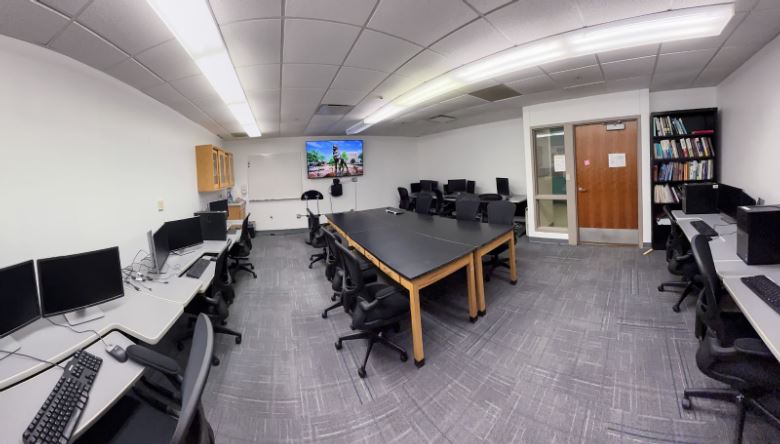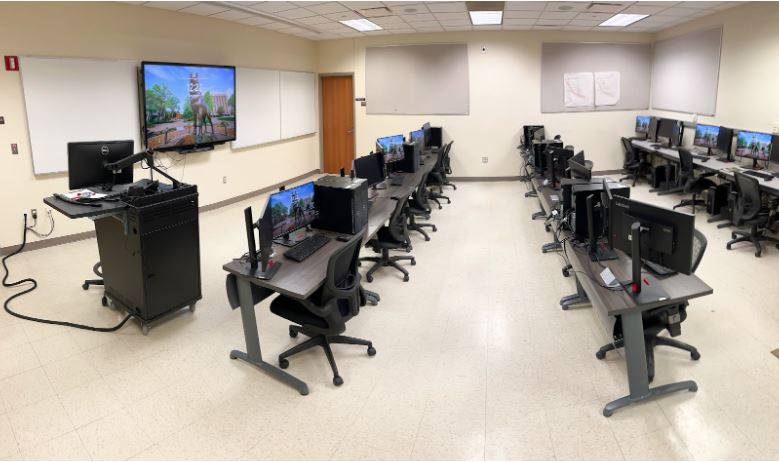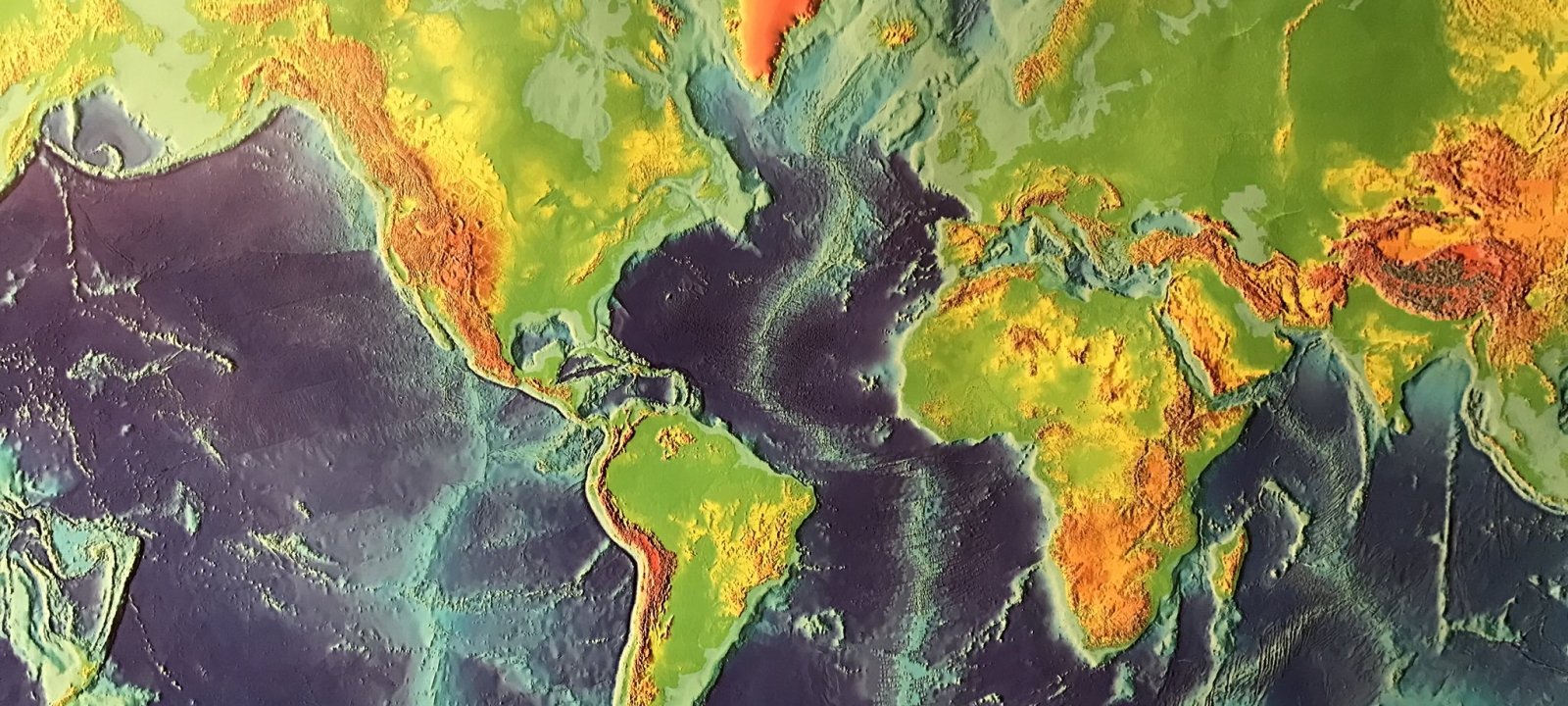Aquatic Chemistry Lab
Aquatic optics support a variety of applications, including remote sensing and environmental change research, in the Aquatic Chemistry Laboratory located in the Great Lakes Research Center. Through optical characterization techniques employing a full suite of analytical tools, our lab allows us to study in-water constituents—and make discoveries that benefit not only the Great Lakes, but aquatic systems worldwide.
Location: GLRC 207
Contact: Aleksey Smirnov
Earth and Environmental Magnetism Lab
Lab activities in the Earth and Environmental Magnetism Laboratory (EEML) include basic and applied research in paleomagnetism, rock and mineral magnetism, and environmental magnetism. The facility offers several instruments, including a superconducting rock magnetometer, an alternating gradient field magnetometer, and a magnetic susceptibility meter.
Lab Tour: Earth Magnetism Laboratory
Location: Dow 109, 618
Contact: Aleksey Smirnov
Earth Explorers Computer Lab (EECL)
A Multifunctional Hub
Designed to foster creativity and collaboration, the Earth Explorers Computer Laboratory is a dynamic multi-functional space tailored for GMES students pursuing their research, coursework, and senior projects. Designed to foster creativity and collaboration, the laboratory is equipped with several high-performance workstations featuring AppsAnywhere technology and proprietary software. Students have access to many specialized applications, data processing tools, modeling software applications, and image processing. The computers in EECL also provide access to Michigan Tech’s high-performance computing cluster. This dynamic space now features a spacious TV screen, a lectern, and video-conferencing equipment and serves as a geophysics reference library. Additionally, the lab serves as a multi-purpose space, doubling as a classroom for various GMES courses as well as a meeting space for research groups. The room’s ambiance was revitalized with brand-new carpeting and fresh paint, giving it an inviting vibe.
Location: Dow 619
Contact: Radwin Askari

Earthquake Seismology Lab
The Earthquake Seismology Laboratory houses a seismograph which records seismic activity and earthquakes from around the world. Portable seismographs have also been used in public schools to aid in teaching students the science behind these phenomena. The lab is also used to test and calibrate instrumentation being prepared for use in the field. Researchers also maintain UPSeis (UP Seismology), an educational site for budding seismologists.
Location: Dow 109A
Contact: Greg Waite
Enterprise
Enterprises are student-led companies embracing rich experiences in engineering design, team building, project management, and end-to-end original product development. The program gives teams of students from varied disciplines the opportunity to work for several semesters in a business-like setting to solve real-world problems supplied by industry partners.
Enterprise teams perform testing and analysis, make recommendations, manufacture parts, develop products and processes, provide services, meet budgets and schedules, and manage multiple projects—and the department supplies the facilities to help teams maximize their productivity and save time.
Environmental Geochemistry Lab
The Environmental Geochemistry Laboratory is used for experimental studies of hydrogeological processes in surface and groundwater. The lab houses instrumentation for the preparation and analysis of water samples and for conducting bench top experiments. Field research and sampling efforts by lab members are supported by field deployable environmental sensing equipment, which is used to collect high temporal resolution environmental data from wells, streams, lakes, and caves.
Location: Dow 218
Contact: John S. Gierke
Fluid Inclusion Lab
The Fluid Inclusion Laboratory contains state of the art equipment used for studying fluid inclusions either formed in natural environments or from synthetic materials.
Fluid inclusions trapped in rocks record the composition, temperature, and pressure of formation and provide crucial information on the role that fluids play in a variety of geologic processes in environments throughout the Earth’s crust. Here primarily study fluid inclusions from rocks derived associated with both active and fossil volcano-hosted geothermal systems to understand better the relationship between fluid evolution in the shallow crust and permeability. These studies form the basis for understanding the heat and mass transfer at depths relevant for exploiting geothermal resources for energy production.
Location: Dow 317
Contact: Chad Deering
Geophysics Lab
The Geophysics Laboratory is used to store, maintain, and test equipment needed for field geophysics courses and research. It also includes a battery charging station for field equipment.
Location: Dow 220
Contact: Jeremy Shannon
Graduate Student Computing Lab
In addition to Windows, Linux, and/or Apple computers in faculty and graduate student offices, the department houses a graduate research/instructional computer lab equipped with standard office productivity software and image analysis/processing software such as ENVI, ERDAS Imagine, ESRI ArcGIS, and MATLAB. Dedicated storage and web hosting are available for this project.
Location: Dow 211
Contact: IT Support
High Frequency Acoustics and Seismic Lab
The High Frequency Acoustics and Seismic Laboratory currently specializes in tomographic imaging of elastic solids.
Location: Dow 623
Contact: Roger Turpening
Mine Design and System Simulation Lab (MDSS)
The Mine Design and System Simulation (MDSS) Laboratory is designed and developed for both teaching and research purposes in the department. The MDSS Lab is a modern computer mine design and simulation laboratory, fully equipped with the Sharp AQUOS BOARD Interactive Display System, audio-video equipment, and state-of-the-art, powerful computers with advanced mine design, planning, and simulation software packages. This lab also includes a smart interactive center room for video conferences and online communications. The MDSS Lab is created to enhance and facilitate the potential of teaching and conducting modern mining projects at Michigan Tech.
Thanks to the generous support of our Mining Engineering alumni, we replaced all the computers in our Mine Design and System Simulation Laboratory (Dow 709) with new cutting-edge, powerful computers with advanced mine design, planning, and simulation software packages. At the same time, the laboratory capacity was increased to 15 seats. The MDSS Laboratory supports teaching, senior design, and research activities. The lab is fully equipped with the Sharp AQUOS BOARD Interactive Display System, and advanced audio-video equipment. This lab also includes a smart interactive center room for video conferences and online communications. The MDSS Lab is created to enhance and facilitate the potential of teaching and conducting modern mining projects at Michigan Tech. This upgrade will further enhance collaboration and foster innovation among our students and researchers.
Location: Dow 709
Contact: Snehamoy Chatterjee

Optical Petrology Lab
The Optical Petrology Laboratory holds four petrographic microscopes which have imaging capabilities and are linked to a computer and high definition LCD TV for projection. In addition, there are several more student petrographic microscopes.
Location: Dow 313
Contact: Chad Deering
